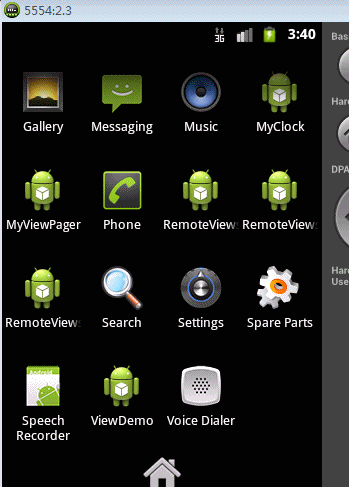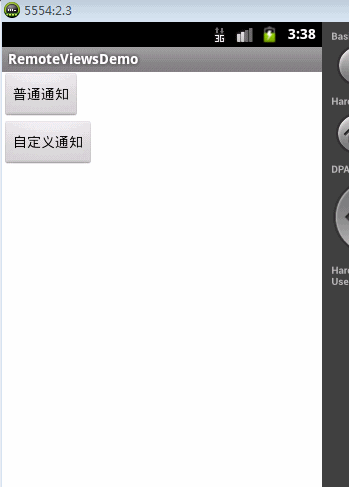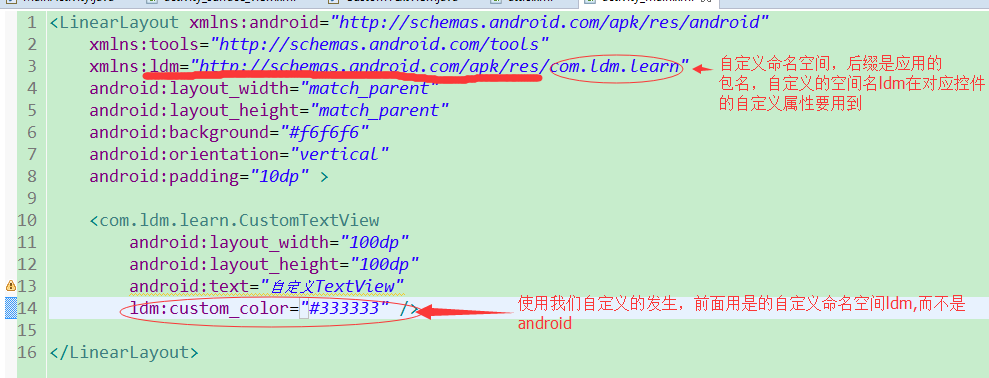編輯:關於Android編程
什麼是RemoteViews?從字面意思可以理解為遠程View。需要注意的是,RemoteViews並不是View的子類,它是Object的子類。它的作用是可以跨進程更新界面,是不是功能很強大?它在實際應用中主要在通知欄和桌面小控件,下面就全部基於通知欄來分析。


定義了兩個按鈕,分別用來發送不同的通知
java代碼
case R.id.btn_normal:
//1.創建通知對象
Notification nf = new Notification() ;
//2.通知的一些常用設置
//圖標
nf.icon = R.drawable.ic_launcher ;
//通知時間
nf.when = System.currentTimeMillis();
//消息來臨時顯示的提示信息
nf.tickerText = "這是普通的通知";
//設置通知自動取消
nf.flags = Notification.FLAG_AUTO_CANCEL;
//3.創建延時意圖
Intent intent = new Intent(this,NormalNotificationActivity.class);
PendingIntent pi = PendingIntent.getActivity(this, 0, intent, PendingIntent.FLAG_UPDATE_CURRENT);
//
nf.setLatestEventInfo(this, "普通通知", "這是來自普通通知的摘要信息", pi);
//4.創建notificationmanager對象
NotificationManager nm = (NotificationManager) getSystemService(NOTIFICATION_SERVICE);
//這裡的id最好保證每次都是不一樣的,否則第二次發送無效
nm.notify(nId++ , nf);
break;
這只是一個簡單的通知,並沒有涉及RemoteViews,主要是知道普通的通知應該如何書寫。
case R.id.btn_zdy:
//1.創建通知對象
Notification myNf = new Notification() ;
//2.通知的一些常用設置
//圖標
myNf.icon = R.drawable.ic_launcher ;
//通知時間
myNf.when = System.currentTimeMillis();
myNf.tickerText = "這是自定義的通知";
myNf.flags = Notification.FLAG_AUTO_CANCEL;
//3.創建延時意圖
Intent myIntent = new Intent(this,NormalNotificationActivity.class);
PendingIntent myPi = PendingIntent.getActivity(this, 0, myIntent, PendingIntent.FLAG_UPDATE_CURRENT);
/**
* 注意:這個字段是要配合nf.contentView這個字段一起使用的,如果只是設置一個會報錯
* nf.contentIntent = pi ;
*/
/******************
*沒有設置contentIntent時:java.lang.IllegalArgumentException: contentIntent required: pkg=com.lw.remoteviewsdemo id=0 notification=Notification(vibrate=null,sound=null,defaults=0x0,flags=0x10)
* ****************************/
//4.創建RemoteViews
RemoteViews rv = new RemoteViews(getPackageName(),R.layout.activity_mynotification);
//給remoteviews手動設置值
rv.setTextViewText(R.id.msg, "我是自定義通知");
rv.setTextViewText(R.id.des, "我是對自定義通知的一些簡單描述信息");
myNf.contentView = rv ;
myNf.contentIntent = myPi ;
//5.創建notificationmanager對象
NotificationManager myNm= (NotificationManager) getSystemService(NOTIFICATION_SERVICE);
//這裡的id最好保證每次都是不一樣的,否則第二次發送無效
myNm.notify(nId++ , myNf);
break;
這是自定義通知,上面的都有注釋,就幾個注意的地方說下,使用自定義通知需要為通知的這兩個屬性賦值,否則就會報上面提到的異常,少一個都不行。
myNf.contentView = rv ;
myNf.contentIntent = myPi ;
還有一點就是在通知myNm.notify(nId++ , myNf)的第一個參數不要設置為一個常量,否則只能發送一個通知。
在概述中提到,RemoteViews是跨進程更新UI的,也就是通過Binder,那麼也就是說RemoteViews肯定實現了序列化接口,看源碼:
public class RemoteViews implements Parcelable, Filter
再看上面的例子,RemoteViews是如何自定義一些文本內容的呢,大部分都是通過setTextViewText()等方法完成的,看源碼
public void setTextViewText(int viewId, CharSequence text) {
setCharSequence(viewId, "setText", text);
}
調用了setCharSequence方法,注意:這裡的第二個參數是setText,是不是和TextView的setText很像呢,點進去
public void setCharSequence(int viewId, String methodName, CharSequence value) {
addAction(new ReflectionAction(viewId, methodName, ReflectionAction.CHAR_SEQUENCE, value));
}
那麼ReflectionAction又是什麼東西呢?從字面可以理解為反射動作。
/**
* Base class for the reflection actions.
*/
private class ReflectionAction extends Action {
static final int TAG = 2;
static final int BOOLEAN = 1;
static final int BYTE = 2;
static final int SHORT = 3;
static final int INT = 4;
static final int LONG = 5;
static final int FLOAT = 6;
static final int DOUBLE = 7;
static final int CHAR = 8;
static final int STRING = 9;
static final int CHAR_SEQUENCE = 10;
static final int URI = 11;
// BITMAP actions are never stored in the list of actions. They are only used locally
// to implement BitmapReflectionAction, which eliminates duplicates using BitmapCache.
static final int BITMAP = 12;
static final int BUNDLE = 13;
static final int INTENT = 14;
從源碼可以看出,它是Action的子類,從注釋可以看出它是反射類的基類,通過之前傳遞過來的setText來進行反射獲取信息,這個類需要配合一會分析的RemoteViews的apply()方法配合看。再回到前面的addAction方法
/**
* Add an action to be executed on the remote side when apply is called.
*
* @param a The action to add
*/
private void addAction(Action a) {
if (hasLandscapeAndPortraitLayouts()) {
throw new RuntimeException("RemoteViews specifying separate landscape and portrait" +
" layouts cannot be modified. Instead, fully configure the landscape and" +
" portrait layouts individually before constructing the combined layout.");
}
if (mActions == null) {
mActions = new ArrayList();
}
mActions.add(a);
// update the memory usage stats
a.updateMemoryUsageEstimate(mMemoryUsageCounter);
}
可以看出,系統首先判斷mActions是否為null,如果為null,則創建一個存放Action的List集合,然後就將傳遞過來的Action添加到mActions中。再來看一些Action源碼
/**
* Base class for all actions that can be performed on an
* inflated view.
*
* SUBCLASSES MUST BE IMMUTABLE SO CLONE WORKS!!!!!
*/
private abstract static class Action implements Parcelable {
public abstract void apply(View root, ViewGroup rootParent,
OnClickHandler handler) throws ActionException;
public static final int MERGE_REPLACE = 0;
public static final int MERGE_APPEND = 1;
public static final int MERGE_IGNORE = 2;
public int describeContents() {
return 0;
}
/**
* Overridden by each class to report on it's own memory usage
*/
public void updateMemoryUsageEstimate(MemoryUsageCounter counter) {
// We currently only calculate Bitmap memory usage, so by default, don't do anything
// here
return;
}
public void setBitmapCache(BitmapCache bitmapCache) {
// Do nothing
}
public int mergeBehavior() {
return MERGE_REPLACE;
}
public abstract String getActionName();
public String getUniqueKey() {
return (getActionName() + viewId);
}
int viewId;
}
從注釋可以看出它是一個在被填充的展現出來的所有Action的基類,實現Parcelable接口。
簡單來說setTextViewText(int viewId, CharSequence text) 方法首先將其封裝成一個動作Action類,然後添加到一個actions集合中去。
接著,再來看看RemoteViews的apply方法
public View apply(Context context, ViewGroup parent) {
return apply(context, parent, null);
}
再點進去
public View apply(Context context, ViewGroup parent, OnClickHandler handler) {
RemoteViews rvToApply = getRemoteViewsToApply(context);
View result;
Context c = prepareContext(context);
LayoutInflater inflater = (LayoutInflater)
c.getSystemService(Context.LAYOUT_INFLATER_SERVICE);
inflater = inflater.cloneInContext(c);
inflater.setFilter(this);
result = inflater.inflate(rvToApply.getLayoutId(), parent, false);
rvToApply.performApply(result, parent, handler);
return result;
}
首先,通過上下文獲取RemoteViews,然後調用performApply()方法,再看下performApply()源碼
private void performApply(View v, ViewGroup parent, OnClickHandler handler) {
if (mActions != null) {
handler = handler == null ? DEFAULT_ON_CLICK_HANDLER : handler;
final int count = mActions.size();
for (int i = 0; i < count; i++) {
Action a = mActions.get(i);
a.apply(v, parent, handler);
}
}
}
這裡就可以看出來了,首先判斷mActions集合是否為null,不為null,依次遍歷actions,然後將處理交給action的apply方法,由於之前我調用的是setTextViewText方法,在那裡添加的action的是ReflectionAction,所以這裡查看的是ReflectionAction的apply方法,
@Override
public void apply(View root, ViewGroup rootParent, OnClickHandler handler) {
final View view = root.findViewById(viewId);
if (view == null) return;
Class param = getParameterType();
if (param == null) {
throw new ActionException("bad type: " + this.type);
}
Class klass = view.getClass();
Method method;
try {
method = klass.getMethod(this.methodName, getParameterType());
}
catch (NoSuchMethodException ex) {
throw new ActionException("view: " + klass.getName() + " doesn't have method: "
+ this.methodName + "(" + param.getName() + ")");
}
if (!method.isAnnotationPresent(RemotableViewMethod.class)) {
throw new ActionException("view: " + klass.getName()
+ " can't use method with RemoteViews: "
+ this.methodName + "(" + param.getName() + ")");
}
try {
//noinspection ConstantIfStatement
if (false) {
Log.d(LOG_TAG, "view: " + klass.getName() + " calling method: "
+ this.methodName + "(" + param.getName() + ") with "
+ (this.value == null ? "null" : this.value.getClass().getName()));
}
method.invoke(view, this.value);
}
catch (Exception ex) {
throw new ActionException(ex);
}
}
從上面的代碼可以看出,主要是通過反射來執行代碼,而方法名之前也已經有了,只需要調用invoke即可。OK,這就是RemoteViews的大致流程了。下面就這種思想使用RemoteViews來實現一個跨進程更新UI的例子
創建兩個應用,一個作為本地,一個作為遠程,當然如果想要在一個應用使用兩個Activity實現也是可以的,只需要在其中一個你想要的Activity作為遠程Activity中的配置文件中指定以下代碼即可,我這裡就是使用兩個應用,效果觀看更加明顯。
android:process=":remote"
通知欄的跨進程是通過Binder實現的,我這裡就通過廣播接受者來實現。OK,上代碼
本地布局文件
子LinearLayout是用來存放從遠程傳遞過來的布局的。
本地java代碼
public class MainActivity extends Activity {
private IntentFilter filter;
@Override
protected void onCreate(Bundle savedInstanceState) {
super.onCreate(savedInstanceState);
setContentView(R.layout.activity_main);
ll_layout = (LinearLayout) findViewById(R.id.ll_layout);
filter = new IntentFilter("com.lw.remoteviewstest1");
registerReceiver(mRemoteViewsReceiver, filter);
}
private BroadcastReceiver mRemoteViewsReceiver = new BroadcastReceiver() {
@Override
public void onReceive(Context context, Intent intent) {
RemoteViews remoteViews = intent
.getParcelableExtra("remoteViews");
if (remoteViews != null) {
updateLayout(remoteViews);
}
}
};
private LinearLayout ll_layout;
@Override
protected void onDestroy() {
super.onDestroy();
//反注冊廣播接受者
if(mRemoteViewsReceiver != null ){
unregisterReceiver(mRemoteViewsReceiver);
}
}
/**
* 根據remoteViews更新ui
* @param remoteViews
*/
protected void updateLayout(RemoteViews remoteViews) {
View view = remoteViews.apply(this, ll_layout);
ll_layout.addView(view);
};
}
主要在onCreate動態創建一個廣播接收者,然後再onDestory中反注冊,當從遠程獲取到remoteViews的時候調用updateLayout的方法,通過remoteViews的apply方法,這個方法前面已經詳細分析了,就不在談了。
遠程布局文件
遠程java代碼
public void send(View view){
//創建remoteviews
RemoteViews rv = new RemoteViews(getPackageName(),R.layout.activity_notification);
//創建intent,設置當點擊按鈕時要跳轉的Activity
Intent sendIntent = new Intent(this,SecondActivity.class);
//創建延時意圖
PendingIntent pendingIntent = PendingIntent.getActivity(this, 0, sendIntent, PendingIntent.FLAG_UPDATE_CURRENT);
//為延時意圖中的按鈕設置點擊事件
rv.setOnClickPendingIntent(R.id.btn_toast, pendingIntent) ;
//創建隱式跳轉
Intent intent = new Intent("com.lw.remoteviewstest1");
//將RemoteViews帶到應用一中去
intent.putExtra("remoteViews", rv);
//發送廣播
sendBroadcast(intent);
}
這裡提下,如果想要為remoteviews添加點擊事件,則必須使用PendingIntent,其實最後還是通過添加action,不過這裡的action不是前面提到的反射action,而是SetOnClickPendingIntent,我們可以看下這個類的apply方法,這裡只需要看最後一個代碼,最後調用了setOnclickListener方法,其它的注釋都比較詳細,就不說了。
@Override
public void apply(View root, ViewGroup rootParent, final OnClickHandler handler) {
final View target = root.findViewById(viewId);
if (target == null) return;
// If the view is an AdapterView, setting a PendingIntent on click doesn't make much
// sense, do they mean to set a PendingIntent template for the AdapterView's children?
if (mIsWidgetCollectionChild) {
Log.w(LOG_TAG, "Cannot setOnClickPendingIntent for collection item " +
"(id: " + viewId + ")");
ApplicationInfo appInfo = root.getContext().getApplicationInfo();
// We let this slide for HC and ICS so as to not break compatibility. It should have
// been disabled from the outset, but was left open by accident.
if (appInfo != null &&
appInfo.targetSdkVersion >= Build.VERSION_CODES.JELLY_BEAN) {
return;
}
}
if (target != null) {
// If the pendingIntent is null, we clear the onClickListener
OnClickListener listener = null;
if (pendingIntent != null) {
listener = new OnClickListener() {
public void onClick(View v) {
// Find target view location in screen coordinates and
// fill into PendingIntent before sending.
final float appScale = v.getContext().getResources()
.getCompatibilityInfo().applicationScale;
final int[] pos = new int[2];
v.getLocationOnScreen(pos);
final Rect rect = new Rect();
rect.left = (int) (pos[0] * appScale + 0.5f);
rect.top = (int) (pos[1] * appScale + 0.5f);
rect.right = (int) ((pos[0] + v.getWidth()) * appScale + 0.5f);
rect.bottom = (int) ((pos[1] + v.getHeight()) * appScale + 0.5f);
final Intent intent = new Intent();
intent.setSourceBounds(rect);
handler.onClickHandler(v, pendingIntent, intent);
}
};
}
target.setOnClickListener(listener);
}
}
Demo整體思路:遠程主要通過Intent攜帶RemoteViews傳遞到本地連接,本地連接獲取到RemoteViews之後,調用apply方法返回個View對象,這個view對象就是遠程RotateViews攜帶的布局,然後添加到本地對應的布局中去。
OK,這篇關於RemoteViews的學習總結就到這了
 詳解Android自定義控件屬性
詳解Android自定義控件屬性
在Android開發中,往往要用到自定義的控件來實現我們的需求或效果。在使用自定義 控件時,難免要用到自定義屬性,那怎麼使用自定義屬性呢?在文件res/values/下新
 Android 圓形旋轉菜單
Android 圓形旋轉菜單
最近幫朋友做了一個動畫菜單,感覺有一定的實用價值,就在此給大家分享一下,先看看效果:源碼下載地址在末尾實現思路:從圖中可以看出,這三個(或更多,需要自己再實現)菜單是圍繞
 Android入門:多線程斷點下載詳細介紹
Android入門:多線程斷點下載詳細介紹
本案例在於實現文件的多線程斷點下載,即文件在下載一部分中斷後,可繼續接著已有進度下載,並通過進度條顯示進度。也就是說在文件開始下載的同時,自動創建每個線程的下載進度的本地
 高通Quick Charge 2.0快充技術從入門到精通
高通Quick Charge 2.0快充技術從入門到精通
高通Quick Charge 2.0快充技術(下稱QC2.0),近日成為了我們關注的焦點,同時也是整個行業熱議的話題。在此之前快充只能通過提升電流的方式來達